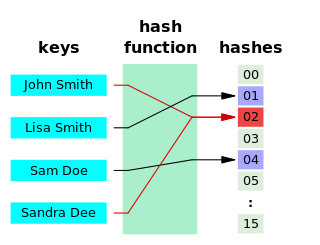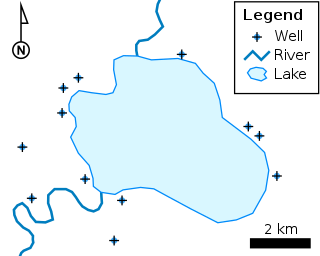Related Research Articles

A hash function is any function that can be used to map data of arbitrary size to fixed-size values, though there are some hash functions that support variable-length output. The values returned by a hash function are called hash values, hash codes, hash digests, digests, or simply hashes. The values are usually used to index a fixed-size table called a hash table. Use of a hash function to index a hash table is called hashing or scatter-storage addressing.

A digital signature is a mathematical scheme for verifying the authenticity of digital messages or documents. A valid digital signature on a message gives a recipient confidence that the message came from a sender known to the recipient.

The Geography Markup Language (GML) is the XML grammar defined by the Open Geospatial Consortium (OGC) to express geographical features. GML serves as a modeling language for geographic systems as well as an open interchange format for geographic transactions on the Internet. Key to GML's utility is its ability to integrate all forms of geographic information, including not only conventional "vector" or discrete objects, but coverages and sensor data.
A commitment scheme is a cryptographic primitive that allows one to commit to a chosen value while keeping it hidden to others, with the ability to reveal the committed value later. Commitment schemes are designed so that a party cannot change the value or statement after they have committed to it: that is, commitment schemes are binding. Commitment schemes have important applications in a number of cryptographic protocols including secure coin flipping, zero-knowledge proofs, and secure computation.
In cryptography, a zero-knowledge proof is a protocol in which one party can convince another party that some given statement is true, without conveying to the verifier any information beyond the mere fact of that statement's truth. The intuition underlying zero-knowledge proofs is that it is trivial to prove possession of the relevant information simply by revealing it; the hard part is to prove this possession without revealing this information.
In cryptography, a random oracle is an oracle that responds to every unique query with a (truly) random response chosen uniformly from its output domain. If a query is repeated, it responds the same way every time that query is submitted.
In cryptography, a message authentication code (MAC), sometimes known as an authentication tag, is a short piece of information used for authenticating and integrity-checking a message. In other words, to confirm that the message came from the stated sender and has not been changed. The MAC value allows verifiers to detect any changes to the message content.
Secure multi-party computation is a subfield of cryptography with the goal of creating methods for parties to jointly compute a function over their inputs while keeping those inputs private. Unlike traditional cryptographic tasks, where cryptography assures security and integrity of communication or storage and the adversary is outside the system of participants, the cryptography in this model protects participants' privacy from each other.

ISO 6709, Standard representation of geographic point location by coordinates, is the international standard for representation of latitude, longitude and altitude for geographic point locations.
A deterministic encryption scheme is a cryptosystem which always produces the same ciphertext for a given plaintext and key, even over separate executions of the encryption algorithm. Examples of deterministic encryption algorithms include RSA cryptosystem, and many block ciphers when used in ECB mode or with a constant initialization vector.
In cryptography, a verifiable random function (VRF) is a public-key pseudorandom function that provides proofs that its outputs were calculated correctly. The owner of the secret key can compute the function value as well as an associated proof for any input value. Everyone else, using the proof and the associated public key, can check that this value was indeed calculated correctly, yet this information cannot be used to find the secret key.
EPOC is a probabilistic public-key encryption scheme.
In cryptography the standard model is the model of computation in which the adversary is only limited by the amount of time and computational power available. Other names used are bare model and plain model.
Non-interactive zero-knowledge proofs are cryptographic primitives, where information between a prover and a verifier can be authenticated by the prover, without revealing any of the specific information beyond the validity of the statement itself. This makes direct communication between the prover and verifier unnecessary, effectively removing any intermediaries.
The Decision Linear (DLIN) assumption is a computational hardness assumption used in elliptic curve cryptography. In particular, the DLIN assumption is useful in settings where the decisional Diffie–Hellman assumption does not hold. The Decision Linear assumption was introduced by Boneh, Boyen, and Shacham.
SHA-3 is the latest member of the Secure Hash Algorithm family of standards, released by NIST on August 5, 2015. Although part of the same series of standards, SHA-3 is internally different from the MD5-like structure of SHA-1 and SHA-2.

The geo URI scheme is a Uniform Resource Identifier (URI) scheme defined by the Internet Engineering Task Force's RFC 5870 as:
a Uniform Resource Identifier (URI) for geographic locations using the 'geo' scheme name. A 'geo' URI identifies a physical location in a two- or three-dimensional coordinate reference system in a compact, simple, human-readable, and protocol-independent way.
Quantum cryptography is the science of exploiting quantum mechanical properties to perform cryptographic tasks. The best known example of quantum cryptography is quantum key distribution, which offers an information-theoretically secure solution to the key exchange problem. The advantage of quantum cryptography lies in the fact that it allows the completion of various cryptographic tasks that are proven or conjectured to be impossible using only classical communication. For example, it is impossible to copy data encoded in a quantum state. If one attempts to read the encoded data, the quantum state will be changed due to wave function collapse. This could be used to detect eavesdropping in quantum key distribution (QKD).

Amit Sahai is an Indian-American computer scientist. He is a professor of computer science at UCLA and the director of the Center for Encrypted Functionalities.
The notion of non-malleable codes was introduced in 2009 by Dziembowski, Pietrzak, and Wichs, for relaxing the notion of error-correction and error-detection. Informally, a code is non-malleable if the message contained in a modified code-word is either the original message, or a completely unrelated value. Non-malleable codes provide a useful and meaningful security guarantee in situations where traditional error-correction and error-detection is impossible; for example, when the attacker can completely overwrite the encoded message. Although such codes do not exist if the family of "tampering functions" F is completely unrestricted, they are known to exist for many broad tampering families F.
References
- ↑ Ran Canetti and Marc Fischlin; Universally Composable Commitments; Cryptology ePrint Archive: Report 2001/055 (link)
- ↑ Marc Fischlin, Roger Fischlin: Efficient Non-malleable Commitment Schemes. CRYPTO 2000: 413–431 (link)
- ↑ Ivan Damgård: Efficient Concurrent Zero-Knowledge in the Auxiliary String Model. EUROCRYPT 2000: 418–430 (link)